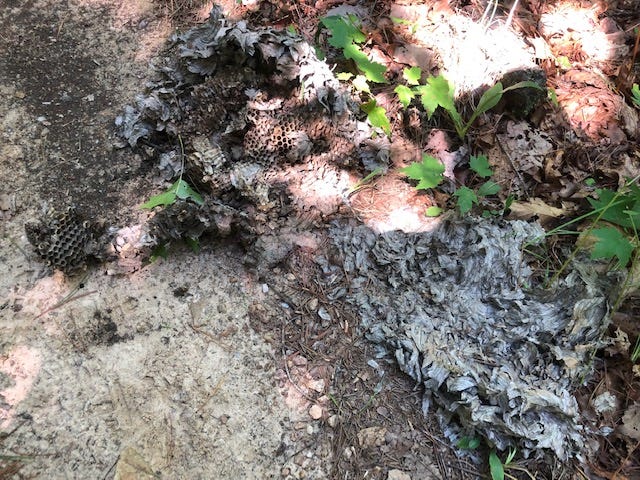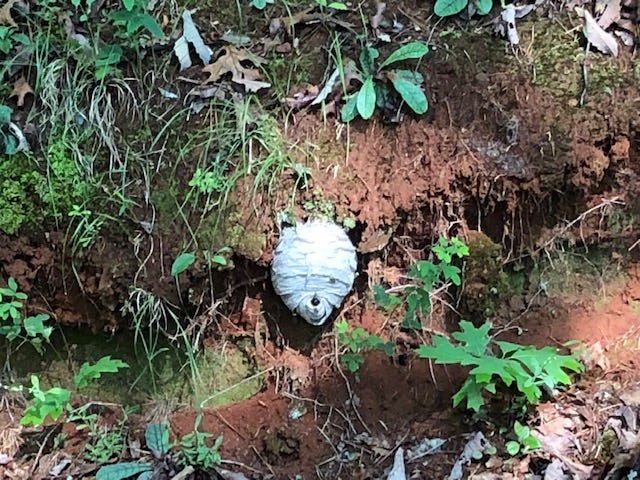Welcome to Natural Wonders, where I notice interesting things out in the woods and discover they’re even weirder than I thought once I start to research them. If you’d like to see weird stories from the past, check out the archive. If you’re not already a subscriber and you’d like a little nature in your inbox each week, click below:
I’ve seen wasp nests all my life, and I know they’re called “paper wasps” by a lot of folks, but it hadn’t really occurred to me to really think of them as paper, like the kind you can write on, until two days ago. I was on a bike ride with some friends, climbing a long hill when I thankfully came across this hornet’s nest on the ground, a good excuse to stop for a breather:
It was probably leftover from last summer and had blown out of a tree in a recent storm, exploding when it hit the ground. Inside were paper honeycombs, just like regular wasps make on the eaves of our house, but surrounding it were the remnants of what was probably a basketball-sized paper ball of a nest.
The more I thought about it, the more amazing I found it to be – a small insect the size of a quarter somehow works with its brethren to make a nest out of paper?! How does it not blow away in a storm while they’re living in it? Why doesn’t it melt as soon as it’s rained on? How do they construct it with all those layers, like flaky French pastry?
How do hornets make nests out of paper?
I found out, first of all, that the bald-faced hornets that made the nest I found are actually not hornets at all – they’re wasps. The only true hornets we have in the U.S. are European hornets, which arrived back in 1850 with settlers from the Old World. These hornets are also known as Giant Hornets because they’re an inch long and fairly intimidating. However, they eat large insects like grasshoppers and yellow jackets, so they can be helpful to have around. They only sting when you get within a few feet of their nest, which I unfortunately know from personal experience. I got stung while riding past a nest on our property and it felt like being hit with a 2x4 board.
These European Hornets are not to be confused with Japanese hornets AKA Asian Giant Hornets AKA Murder Hornets, which arrived in the Pacific Northwest in 2019 but haven’t made their way across the U.S. yet. Japanese hornets are the largest hornet in the world at 1-1/3 inch in length. They decimate honeybee nests – due to their larger size, one hornet can kill 40 honeybees per minute. Because of this, American beekeepers are concerned about the effects on an already stressed honeybee population.
Here’s a really interesting fact I found that’s worth a short diversion: honeybees in Japan have developed a unique defense against Japanese hornets. When a hornet arrives at a hive, the honeybees lure it inside before it can fly off to signal others. As soon as the hornet attacks one bee, the others descend on it, vibrating their bodies as they surround it to raise the temperature. The Japanese hornet can’t withstand the heat and roasts alive. If you want to see it in action, take a look at this video:
Back to the paper nests:
Bees that build paper nests like the European hornets, Japanese hornets, bald-faced hornets (really a wasp), and even yellow jackets all make their nests from scratch each year. Every spring, the queen crawls out of whichever hole she hibernated in and joins other queens to construct a small nest. She scrapes a piece of wood – a log, a board on your deck, even a cardboard box – and holds the wood in her mouth to let her saliva turn it to pulp. She then spreads the pulp with her legs and mandibles to shape cells to lay the eggs. After the queen lays an egg, it hatches into a larva that eats insects the queen brings it, then once it’s grown to fill the cell it creates a silk cover that turns the cell into a cocoon, where it metamorphoses into a hornet. The whole process takes about three weeks.
The nests are usually built during the spring and summer, gradually growing in size over 4-6 months as more larvae hatch to help with the construction. As with ants, most of the bees in the nest are sterile females – the stingless males show up in the late summer to fertilize the new females. These fertilized females then hibernate over the winter and become queens for new nests the following year.
So how do these nests withstand heavy rainstorms without soaking through like wet toilet paper? It turns out the hornets create water-repellant sections at the top of the nest by using saliva that’s heavy in nitrogen from the protein (other bugs) they eat. The top of the nest is slightly shiny and more water-repellant than the bottom sections. Hornets can also suck water out of the paper and spit it out to help dry out the nest.
In early winter, all the workers die off and only the queen remains. She can’t maintain the huge nest by herself, so she finds a tree hole (or your attic) to hide out in for the winter. The paper nest slowly disintegrates without the constant upkeep the workers provided.
And then there’s the Tarantula Hawk…
Tarantula Hawks are a 4 ½ inch-long wasp that lives in Central and South America and the southernmost parts of the U.S. Its sting is almost the most painful in the world, second only to the bullet ant, which also lives in South America (*makes mental note not to visit South America*). It doesn’t actually build a nest, but instead lives alone and hides out in natural holes or animal burrows.
So how do they provide for their young? As their name suggests, they attack tarantula spiders, but not to eat them – they paralyze them and lay their eggs on their backs. The hawk then drags the paralyzed spider to a hole and leaves it inside to serve as food for the larvae to burrow into when they hatch. The tarantula is then eaten from the inside out.
Nature really has an amazing way of providing for every possible adaptation. I started out amazed that insects invented paper eons before humans did and now find myself both amazed and disgusted at the resourcefulness of Tarantula Hawk mothers. Nature does seem to always find a way.
What are your adventures with wasps, hornets and bees nests? I’ll go first: one winter Andrew and I found a cool piece of wood with odd holes drilled down it in a sporadic pattern. Thinking it a neat artifact, we brought it back to our mantel above the fireplace. The next time we built a fire, we ended up with a bumblebee invasion. Lesson learned.
What about you?
Nature break: sit very still, either in your yard or in the forest, and look for bees to fly across your field of vision. Look in particular for the “beeline” - those bees with places to go and people to see. Most likely the place they’re going is home and the “people” are in their hive.
Weird Nature:


Detritus:
People in Japan eat hornets as a delicacy.
Giant hornet vomit can give athletes a competitive edge.
A pest control company hosts a pop-up Pestaurant where they serve “insect-infused dishes” They have a cookbook if you’re interested.
If you liked this issue, please click the “like” button below - it makes me happy and also raises the profile of this newsletter!










The tarantula as food: stuff of Alien films only worse.
I especially like the waterproof “roof” on top of the nest... ingenious!
Note to self: no logs with holes in fireplace.
I love reading your findings!